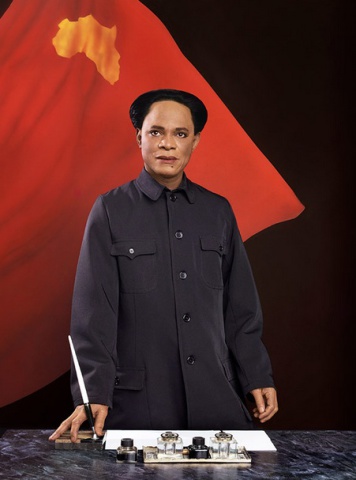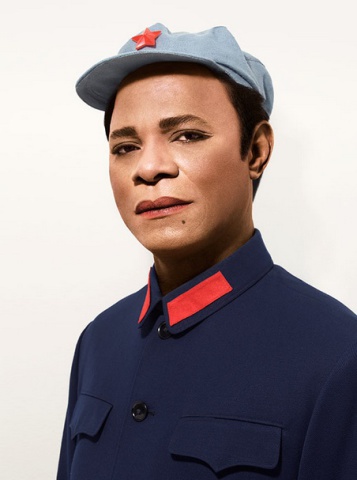




Arthub Favorite: Week Four
In today’s Internet dependent era we all receive a daily bombardment of newsletters, marketing deals and social media alerts. It’s challenging to wade through the excess information in our inbox. But one source Arthub readily supports is Aperture. Created in 1952 by photographers and writers, the not-for-profit foundation acts as a multi-platform publisher and center for the photo community.
Today, Aperture has chosen to feature Samuel Fosso in their digital publishing program. The following article by Olu Oguibe – a professor of art at the University of Connecticut – was originally published in Aperture issue 221, Winter 2015.
Great choice Aperture! Arthub supports the provocative work of Samuel Fosso. Check out Olu’s article below to see the artist’s unique take on Chairman Mao—the Chinese communist revolutionary and founding father of the People’s Republic of China.
Samuel Fosso: Emperor of Africa
A master of theatrical self-portraiture turns toward China.
As a teenage photographer and commercial portrait–studio owner in Bangui, Central African Republic, in the 1970s, Samuel Fosso took turns between client sittings in his studio to reel off self-portrait after self-portrait, modeling the fashion of the day: colorful platform shoes, bell-bottomed pants, huge dark sunglasses, tight-fitted shirts, and blowout Jimmy Cliff rude-boy fisherman hats typical of postcolonial African urban youth of the period. Using his own body and the nonchalant, adventurous power that only a teenage studio proprietor could wield, Fosso produced a formidable look book of African urban youth style in the wealthy, immediate postindependence decade.
After those images were discovered in the 1990s, their cultural significance brought Fosso into a vibrant circle of young African intellectuals: writers, international curators, and artists like Simon Njami and Bili Bidjocka, Okwui Enwezor, Iké Udé, Yinka Shonibare and this author, and Congolese urban chronicler Chéri Samba, among others. He inadvertently became part of a larger conversation, an emerging postcolonial African cultural movement, no less, that was searching for new languages and meanings, and engaged in deeper historical preoccupations relevant not just to the youthful, curious ego, but even more so to that great task that Frantz Fanon posed their generation: to discover its mission, fulfill it, or betray it.
The matrix of social, historical, and conceptual investigations that this movement engaged in began to steer Fosso’s application of the self in front of the camera beyond his earlier preoccupation with the adolescent ego. Before him, Udé was also using self-portraiture, or what he referred to as “the regarded self,” in even more diverse ways—to not only construct critiques of race and representation but rediscover and reinvent the complexities and subtleties of traditional West African ideas of beauty, gender fluidity and role reversal, and theater. Udé’s engagement with his native Igbo traditions of body art and performance, especially Igbo masquerade traditions, certainly held profound meaning for Fosso, who shares the same Igbo heritage, and it was by performing the persona of his late grandfather, an Igbo deity priest, in his series Le rêve de mon grand-père (The dream of my grandfather) in 2003 that Fosso completed his conceptual transition.
Subsequently, in the series African Spirits (2008), in which he reenacts iconic images of African independence and liberation struggle leaders like Kwame Nkrumah, Samora Machel, Haile Selassie, and Nelson Mandela, Fosso in fact created a parallel to the Igbo tradition in which adepts or community members don masquerade costumes to channel ancestral spirits during festive seasons. By donning the costume and transforming oneself into a masking figure, one took on the persona of a visiting ancestor and served as a symbolic or ritual bridge between the past and the present, and even between the sacred and the quotidian. In African Spirits, Fosso transformed himself into a masquerade of sorts, through which the spirits of the guardians of African liberation were made manifest.
In Emperor of Africa (2013), his most recent series, Fosso channels a different spirit by restaging iconic images of Chinese leader Chairman Mao not only as a liberator who, like the subjects of Fosso’s African Spirits series, is highly admired in Africa, but also as the founder and symbol of a modern imperial behemoth that is currently engaged in an expansive long march across Africa. Though China’s growing economic and cultural presence is eagerly embraced by many African leaders, it has raised concerns, especially among the continent’s intellectuals. In a complex, richly layered performance worthy of an African masquerade, Fosso’s Mao is both ancestral figure and absent dictator, almost like the patriarchal leader in Gabriel García Márquez’s 1975 novel Autumn of the Patriarch, who’s never seen yet looms large over his dominion. Fosso, as performer, is both subject and inquisitor, the man behind the mask who interrogates empire and postcolony alike, the ultimate Fanonian “man who questions.”
Find out more about Aperture here.
© Photos Samuel Fosso. Courtesy Jean Marc Patras, Paris and Aperture
About Samuel Fosso
Samuel Fosso (b. 1962, Kumba, Cameroon) is a Cameroonian photographer best known for his autoportraits, in which he transforms himself into other people and characters drawn from popular culture and politics. Nicknamed “The Man of a Thousand Faces,” Fosso’s work embodies the complexities of identity.
In 1993 Fosso’s images were discovered by French photographer Bernard Deschamps, who was looking for photographs to be included in the first edition of Rencontres de la photographie africaine in Bamako, Mali (which later evolved into the Malinese Bamako photography biennale). That 1994 exhibition launched Fosso’s career as an artist, a year later he won the Afrique en Creation award and then the prestigious Prince Claus Award in 2001. Although his work drew comparisons to traditional African studio photographers (such as Seydou Keïta of Mali) and Western photographers who utilized self-portraiture (such as American Cindy Sherman), Fosso operates in relative isolation. Fosso has since continued to exhibit at prominent institutions around the world.
Find out more about Samuel Fosso here.